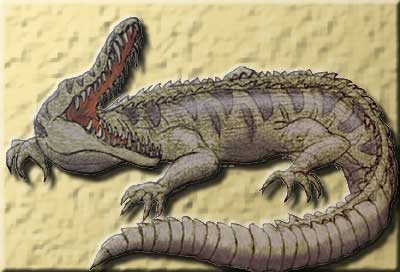 Euphytosauridae: "Crown Group" Phytosaurs
Euphytosauridae: "Crown Group" Phytosaurs| Archosauria | ||
| The Vertebrates | Phytosauridae |
| Vertebrates Home | Vertebrate | Vertebrate |
|
Abbreviated Dendrogram
Archosauromorpha
│
└─Archosauria
├─Proterosuchidae
└─┬─Erythrosuchidae
└─┬─Euparkeriidae
└─Crown Group Archosauria
├─Ornithodira
│ ├─Pterosauria
│ └─Dinosauromorpha
└─Crurotarsi
├─Phytosauridae
│ ├─Parasuchus
│ ├─Paleorhinus
│ └─Euphytosauridae
│ ├─Angistorhinus
│ ├─Brachysuchus
│ └─Rutiodontinae
│ ├─Rutiodon
│ ├─Smilosuchus
│ └─Pseudopalatinae
│ ├─Pseudopalatus
│ ├─Nicrosaurus
│ └─○Mystriosuchus
│ ├─ Mystriosuchus planirostris
│ └─ Mystriosuchus westphali
└─Rauisuchiformes
├─Rauisuchia
│ ├─Ornithosuchidae
│ └─┬─Prestosuchidae
│ └─Rauisuchidae
└─Suchia
├─Aetosauridae
└─Crocodylomorpha
|
Contents
Overview |
 Euphytosauridae: "Crown Group" Phytosaurs
Euphytosauridae: "Crown Group" Phytosaurs
Late Triassic (Late Carnian to Rhaetian) of Europe, India, North America, North Africa (Morocco).
Phytosauridae : Parasuchus + Paleorhinus + * : Angistorhinus + Brachysuchus + "Rutiodontinae".
Characters: nostrils well back, i.e. external nares posterior, between the antorbital fenestrae; squamosals primitively with short rounded posterior process; supratemporal fenestrae primitively at the level of the skull roof; small interpterygoid vacuity; primitively dentition weakly heterodont; primitively non-overlapping scutes; primitively altirostral morphotype.
Comments: This clade could also be called "Euphytosauria", because it includes all phytosaurs more advanced than the basal palaeorhinine condition.
The subfamily Angistorhininae is almost certainly paraphyletic, as it is in some ways transitional between the Palaeorhininae and higher phytosaurs. The angistorhinines were all large animals, often double and more the linear dimensions of the palaeorhinines. The two groups co-existed, filling distinct ecological niches, the palaeorhinines being fish-eaters, and the angistorhinines feeding also on larger animals.
Image: Smilosuchus image donated to Palaeos by Jason Haymond.
References: Chatterjee (1978). MAK030812.
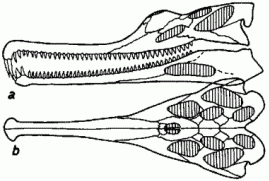 |
|
Skull of Angistorhinus grandis; length 90 to 120 cm. |
Angistorhinus: Angistorhinus grandis, Angistorhinus alticephalus
Late Triassic (Early part of Late Carnian) of North America, North Africa Morocco).
Euphytosauridae : Brachysuchus + "Rutiodontinae" + *.
Characters: large, skull-length 90 to 122 cm; altirostral morphotype; rostrum long and strong with prominent down-turned tip; moderately deep skull, orbit directed outwards and upwards; infratemporal and posttemporal fenestrae both large; posterior squamosal process short and rounded; teeth weakly heterodont with compressed and enlarged posterior teeth; non-overlapping scutes.
References: Chatterjee (1978). MAK030812.
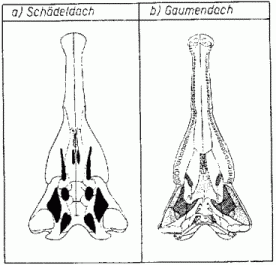 |
|
Skull of Brachysuchus megalodon; length 90 to 120 cm. |
Brachysuchus: Case 1929. B. megalodon
Late Triassic (Early part of Late Carnian) of North America.
Euphytosauridae : Angistorhinus + "Rutiodontinae" + *.
Characters: very large, skull length around 125 cm, rostrum quite short and very heavy; no rostral crest
Links: Phytosauria Translation and Pronunciation Guide.
References: Creisler 1996. MAK030812, ATW031129.
 |
|
Skeleton of Rutiodon carolinensis; overall length 2 to 2.5 meters. |
"Rutiodontinae": Advanced phytosaurs
Late Triassic (Latest Carnian to Rhaetian) of North America and Europe.
Euphytosauridae : Angistorhinus + Brachysuchus + * : Rutiodon + Smilosuchus + Pseudopalatinae.
Characters: medium to very large; moderately deep skull; orbits directed obliquely more outwards than upwards; interpterygoid vacuity small and narrow; supratemporal fenestrae depressed; posterior squamosal process primitively rounded and elongate.
Comments: The subfamily Rutiodontinae is almost certainly paraphyletic, as it is in some ways transitional between the Angistorhininae and Pseudopalatinae. The rutiodontines replaced both the palaeorhinines and Angistorhinines, both earlier groups apparently dying out before the end of the Carnian.
References: Chatterjee (1978). MAK030812.
 |
|
Skull of Rutiodon carolinensis; length 75 cm. |
Rutiodon: Rutiodon carolinensis, Leptosuchus crosbiensis
Late Triassic (Latest Carnian) of North America.
Rutiodontinae : Smilosuchus + Pseudopalatinae + *.
Characters: medium sized, long slender rostrum; dolichorostral morphotype; posterior squamosal process slender; teeth with strong vertical striations; weakly homodont dentition; non-overlapping scutes.
Comments: Phytosaurs attributed to Rutiodon are also recorded from the Norian and Rhaetian of Europe, but there is no guarantee that these species belong to this genus. If they do, these phytosaurs survived there much longer than in North America (western Pangea). Long & Murry (1995) restrict the name to forms known from the East Coast of North America, but the western form Leptosuchus probably is a junior synonym (although a distinct species).
Links: Dinosaur State Park: Rutidon Model (R. carolinensis); We Had Dinosaurs in York County? (skeleton and skull of R. carolinensis); PHYTOSAUR RUTIODON (some nice images and basic information); Rutiodon - Phytosaure de l'Ere Seconadaire image of tooth); [루티오돈(Rutiodon)] Korean); Paleontology and Geology Glossary- R interesting paragraph); Dino Land Travels Database Dinosaur State Park- Rutidon Model; Vertebrate detailed image of scutes); Natural Canvas Fossils - Reptiles 2 teeth & a nice jaw fragment); Yahooligans! Science- Dinosaurs; A PRELIMINARY BIOMECHANICAL; HUBER. ATW030921.
References: Chatterjee (1978); Creisler 1996; Long & Murry (1995); Lucas 1998. MAK030812.
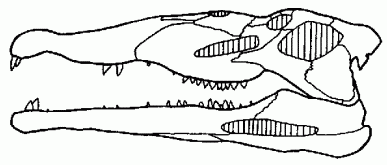 |
|
Skull of Smilosuchus gregorii; length one to one and a half meters. |
Smilosuchus: Smilosuchus gregorii
Late Triassic (Latest Carnian) of North America.
Rutiodontinae : Rutiodon + Pseudopalatinae + *.
Characters: extremely large, skull length 100-155 cm and more; moderately deep skull; rostrum with marked dorsal crest, (hence the older term Machaeroprosopus "knife face," alluding to the sharp crest); squamosal process short and deep; brachyrostral morphotype, short broad massive jaws and strongly heterodont teeth.
Comments: A gigantic phytosaur, Smilosuchus attained up to 12 meters in length, and was the largest land animal of the Triassic.
References: Chatterjee (1978); Creisler 1996. MAK030812.
Pseudopalatinae: Pseudopalatus, Nicrosaurus, Redondasaurus, Mystriosuchus (usually placed in separate subfamily)
Late Triassic (Early Norian to Rhaetian) of North America and Europe.
Rutiodontinae : Rutiodon + Smilosuchus + * : Pseudopalatus + Nicrosaurus + Mystriosuchus.
Characters: large, skull length 80-120 cm; moderately robust rostrum with irregular, vertical longitudinal dorsal crest, posterior squamosal process slender; orbits directed obliquely outwards and upwards;
Comments: The most advanced phytosaurs.
Links: Triassic Page 4 - scroll down for image of "Rutiodon" buceros. MAK030813.
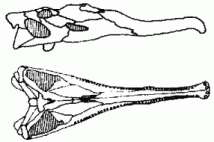 |
|
Skull of Pseudopalatus andersoni; length 85 cm. |
Pseudopalatus: P. andersoni, P. pristinus, Redondasaurus is closely related.
Range: Late Triassic Early Norian to Rhaetian) of North America
Pseudopalatinae : Nicrosaurus + Mystriosuchus + *.
Characters: medium to large, skull length 80-120 cm; moderately robust rostrum with dorsal crest, posterior squamosal process slender; orbits directed obliquely outwards and upwards. MAK030813.
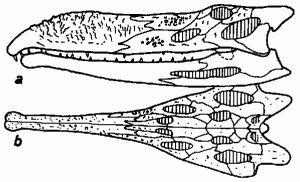 |
|
Skull of Nicrosaurus kapffi; length 65 to 75 cm. |
Nicrosaurus: Fraas, 1866. N. kapffi von Meyer. This taxon has numerous junior synonyms.
Range: Late Triassic Early to Middle Norian) of Europe.
Pseudopalatinae : Pseudopalatus + Mystriosuchus + *.
Characters: medium-sized, skull length 75 cm; skull at least as deep as wide; very pronounced dorsal crest; very strong, croc-like rostrum; dentition strongly heterodont; overlapping scutes.
Comments: A very common European species. Also known as Belodon, this was probably the original "Phytosaurus". Represents a specialized pseudopalatine condition.
Links: NICROSAURUS; IT> ... abstract on heterodonty in Nicrosaurus); Phytosauria Translation and Pronunciation Guide Introduction.
References: Zittel, 1932; Chatterjee (1978). MAK030813.
 |
|
Skeleton of Mystriosuchus planirostris; length 2.9 meters. |
Range: Late Triassic Middle Norian) of Europe.
Pseudopalatinae : Pseudopalatus + Nicrosaurus + *. : Mystriosuchus planirostris + Mystriosuchus westphali
Characters: $ slit-like interpremaxillary fossa; $ triangular cross-section of the postorbito-squamosal bar; $ strongly reduced posttemporal fenestra; distinct cranial sculpture [Hungerbühler 2002]; small to medium-sized, skull length 75-105 cm (specimen cited by Zittel 80 cm, with snout 60 cm), fairly deep; rostrum long and slender; cranium high, sharply separated from the subcylindrical snout; pronounced tusked spoon shaped extension at tip of snout; specialized posterior nares with raised rim, close to orbit; dorsal crest lost; posterior squamosal process extremely reduced; supratemporal fenestrae greatly depressed; orbits directed upwards and backwards; fully homodont dentition of uniform conical teeth, teeth delicately fluted; four series of dorsal plates of nearly equal size, ventral shield of smaller plates protect the throat; skeleton more lightly built than Nicrosaurus; strongly dolichorostral morphotype
Comments: This highly derived and specialized fish-eating genus represented the most extreme dolichorostral adaptation of any phytosaur. It is usually placed in its own subfamily, the Mystriosuchinae, and in appearance and most certainly habits would have paralleled the modern gavial to a great degree. Recent research however shows that Mystriosuchus is nested within the Pseudopalatinae [e.g. Hungerbühler 2002]. And though Mystriosuchus is certainly very different in appaearance to other pseudopalatine phytosaurs, much of this modification is clearly due to specific piscivorous adaptations.
References: Zittel, 1932; Chatterjee (1978); Hungerbühler 2002.
Links: Taxonomic history of Mystriosuchus E. Fraas, 1896
MAK030813 , MAK050119
 |
|
Skull of Mystriosuchus planirostris; length 80 cm. |
Range: Late Triassic Middle Norian) of Europe.
Characters: naris facing forward anteriorly and upward posteriorly, and the longest rostrum and the highest degree of depression of the supratemporal opening in any phytosaur. [Hungerbühler 2002]
Comments: The type species of the genus. Although traditioanlly considered freshwater, like other phytosaurs, a recently discovered specimen from the Calcari di Zorzino of Northern Italy, which seems to belong to this species, apparently took to a completely marine existence, thus foreshadowing the Jurassic Teleosauridae.
Links: Nuova pagina 1; Norian Fauna and Flora (mentions the apparently fully marine (or lagoonal and marine) mystriosuchine found in the Calcari di Zorzino of Northern Italy); Mystriosuchus - Dr Silvio Renesto
MAK050119
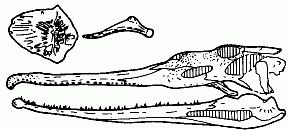 |
|
Skull of Mystriosuchus westphali; |
Range: Late Triassic Middle Norian) of Europe.
Characters: distinct premaxillary crest; $squamosal-prootic contact; $ absence of a posterior process of the squamosal; $, and a slit-like posttemporal fenestra. [Hungerbühler 2002]
Comments: Mystriosuchus westphali is based on a large, well-preserved cranium and a snout fragment from the Stubensandstein (Norian) of south-west Germany [Hungerbühler 2002]. This animal has also been known as Belodon plieningeri and Mystriosuchus plieningeri
MAK050119
checked ATW050704, last modified MAK050119
Using this material. All material by ATW is public domain and may be freely used in any way (also any material jointly written by ATW and MAK). All material by MAK is licensed Creative Commons Attribution License Version 3.0, and may be freely used provided acknowedgement is given. All Wikipedia material is either Gnu Open Source or Creative Commons (see original Wikipedia page for details). Other graphics are copyright their respective owners